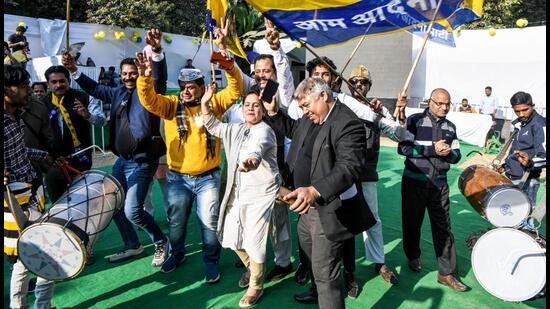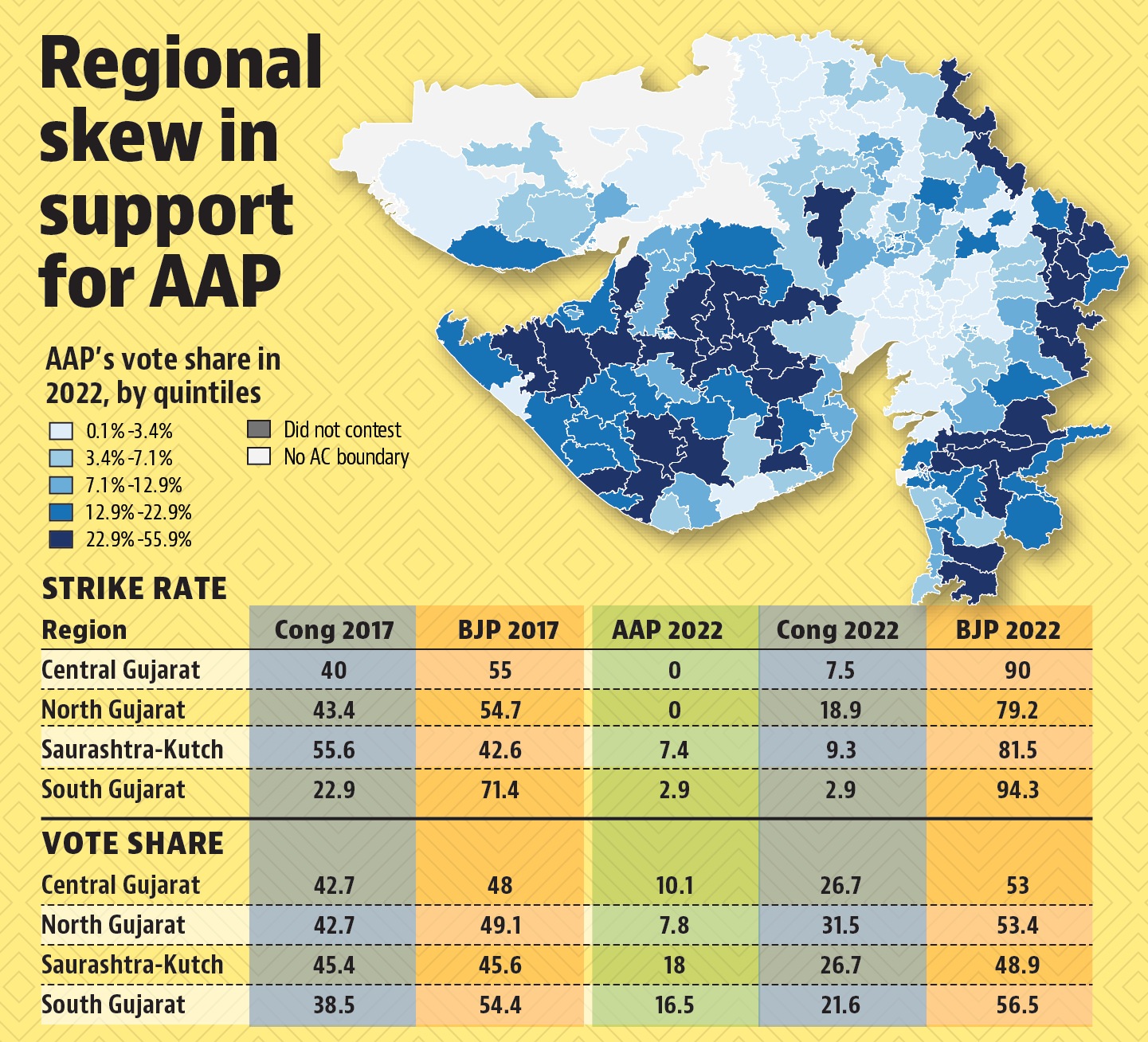AAP needs to solve Gujarat puzzle on way to principal Opposition spot
Across Gujarat’s 182 seats, the BJP increased its tally from 99 seats on 49% vote share in 2017 to 155 seats on 53% vote share.
As expected, the Bharatiya Janata Party (BJP) swept the 2022 election in Gujarat, where it has not lost an election since 1995. The only real question was how many seats the BJP would ultimately win.

Across Gujarat’s 182 seats, the BJP increased its tally from 99 seats on 49% vote share in 2017 to 155 seats on 53% vote share. The 155 seats smashed the record of 149 seats set by Madhav Singh Solanki’s Congress government in 1985. The impressive increase in the number seats from a small vote share increase was no doubt caused by the splitting of non-BJP votes between the new entrant Aam Aadmi Party (AAP) and the perennial challenger Congress (the Solanki government actually scored a significantly higher 56% vote share in the 1985 election).
Thus, to make sense of this election, it useful to understand how the entry of AAP impacted electoral outcome. Overall, AAP won 5 seats on a 13% vote share, but its entry in Gujarati politics is geographically concentrated. It received at least 10% vote share in 70% of the constituencies of Saurashtra and South Gujarat, but it reached the 10% mark in only 29% of the constituencies in Central and North Gujarat.

AAP breaking into Saurashtra is particularly notable, as it is the region where the BJP faced heavy losses to the Congress back in 2017 due to serious farmer discontent. The Congress’ strike rate in Saurashtra dropped from 56% in 2017 to just 9% in the 2022 — due to the split of non-BJP votes between Congress and AAP. Indeed, the combined vote share of AAP and Congress in Saurashtra was higher than that of BJP in 30 constituencies (which would have given this hypothetical combined force a 56% strike rate in the region like 2017). Nonetheless, combined force or not, the BJP was always going to win this election — even the combined vote share of AAP and Congress was higher than BJP’s vote share in just 62 of 182 constituencies.
The other key factor in Gujarat’s election outcomes in the rural-urban divide. Characterization of urban constituencies in a systematic manner is notoriously difficult. In order to make this calculation, I used European Space Agency satellite data, which allows us to calculate the density of settlements across land — a calculation provided by my Centre for Policy Research colleague, Shamindra Nath Roy. I characterized any assembly constituency that has peri-urban or more dense settlements across more than 50% of its land as an “urban” assembly constituency. This yielded a total of 40 urban constituencies, comprising of places across major cities such as Ahmedabad, Vadodara, Rajkot, and Surat.
Gujarat is one of India’s most urbanized states, and urban voters have formed a core vote bank for the BJP. In 2017, the BJP won 35 of 40 urban constituencies for an 88% strike rate. The BJP actually bettered this performance this time, winning 38 of 40 urban constituencies for a 95% strike rate (the other two being won by the Congress). The BJP had a commanding lead in these constituencies, with an average constituency-wise vote share of 63% in urban constituencies. The combined vote share of AAP and Congress was higher than that of BJP’s in just 4 out of 40 urban constituencies.
By contrast, vote-splitting between Congress and AAP was highly consequential in rural areas. Using the aforementioned satellite data, I defined a rural constituency as one in which more than 80% of an assembly constituency’s land has population density that is lesser than that of a peri-urban settlement. This yields a total of 58 rural constituencies, among which the BJP won a total of 46 seats for a strike rate for a strike rate of 78%. Not only did the BJP have a lower strike rate in these areas, but its electoral hold was more precarious. In rural constituencies, the BJP had an average vote share of 48%, more than 15 percentage points lower than urban constituencies. The combined vote share of AAP and Congress was higher than that of BJP in 29 of 58 constituencies, giving this hypothetical combined force a 50% strike rate in rural constituencies.
While AAP did not perform to the level of exit poll predictions, its entry into Gujarat politics is certain to shape the future of the state’s politics. AAP has shown the ability enter areas where the Congress showed greater strength, namely Saurashtra and other rural areas. If these electoral results cause a collapse of a demoralized Congress cadre, AAP will assume electoral control in these areas. It may be a situation similar to five years ago in Punjab, when AAP broke into the Malwa region as precursor to its spread across state (and eventual landslide victory earlier this year). With AAP’s popularity in Delhi, and strong performance in certain municipal polls in Gujarat, it may also be more capable of challenging the BJP in urban Gujarat.
At the same time, AAP’s spread has been seen as possible only in “exceptional cases” such as Delhi and Punjab. Can AAP break into a large state characterized by Congress-BJP competition? It will have invest more significantly in its party cadre in Gujarat if it is to do so. If AAP is able to solve the puzzle of Gujarat, it may serve as a template to replace the Congress as the principal opposition to the BJP at a national level.
But, for now, all this seems quite far away, as the BJP is clearly in a commanding position for the upcoming 2024 national election.






